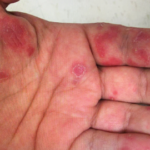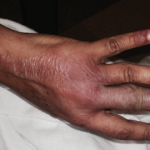Skin changes had been present for a total of five years, at which time I assumed care of the patient. A dermatologist had seen the patient a few times and concluded the patient had ACLE and SCLE with features of Rowell’s syndrome based on physical exam findings. Skin biopsy was deferred given the high likelihood of cutaneous lupus erythematosus and cost to the patient, who was paying out of pocket for her care. I agree that classic discoid lupus erythematosus is another consideration here, and I very much appreciate your educational discussion.
Your point about refractory cutaneous lupus erythematosus due to an unrecognized drug reaction is another worthy teaching pearl. This patient was not routinely taking any prescription or over-the-counter medications before or during her clinical course, aside from those prescribed for management of SLE.
I, too, was continuously surprised by her lack of end-organ manifestations of disease despite years of active SLE serologies and severe cutaneous lupus erythematosus. Urine studies were closely monitored and consistently normal. A genetic complement deficiency state could indeed explain her SLE variant. Thank you for turning our attention to this interesting entity.
“Hydroxychloroquine resistance” is another valid point. The quotations here are deliberate because compliance plays a well-documented role in patients’ “unresponsive to treatment,” as your letter aptly cited. Hydroxychloroquine blood levels were deferred given the associated cost, but I do believe the patient was compliant with her medications. We communicated frequently via electronic messages, and she was always forthcoming about her need for refills, as well as cutaneous flares. The addition of quinacrine was suggested by dermatology colleagues, but was price prohibitive. The patient did not previously or currently smoke.
Regarding therapeutic options for refractory disease, I agree with your diverse suggestions. I’m hopeful new therapies and additional data will provide better answers for these patients in the future. Cost, as you mentioned, continues to be an issue for many.
It’s worth noting that the patient’s care was not only complicated by severe disease, but limited access. She did not have health insurance. Her family’s gross income was too high to qualify for local sliding scale programs, but too low to afford commercial or Marketplace coverage. And even if she had qualified for a local program, biologics and synthetic small molecules wouldn’t be covered.1 She was not approved for lenalidomide’s patient assistance program (PAP). She is currently in the process of applying for tofacitinib via PAP. Despite my clinic’s extensive experience assisting patients with PAP applications, she is yet to receive the medication.2



